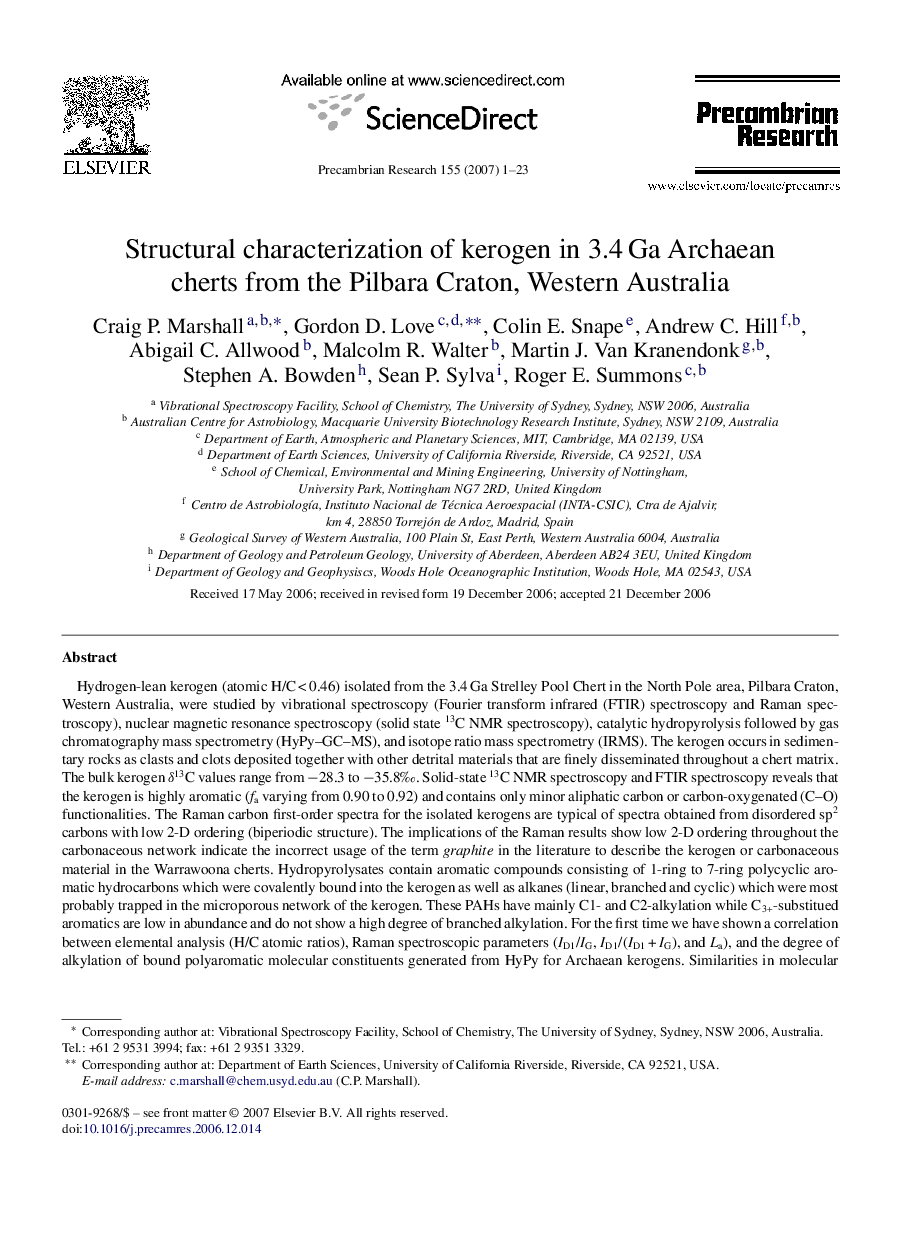| کد مقاله | کد نشریه | سال انتشار | مقاله انگلیسی | نسخه تمام متن |
|---|---|---|---|---|
| 4724453 | 1639719 | 2007 | 23 صفحه PDF | دانلود رایگان |

Hydrogen-lean kerogen (atomic H/C < 0.46) isolated from the 3.4 Ga Strelley Pool Chert in the North Pole area, Pilbara Craton, Western Australia, were studied by vibrational spectroscopy (Fourier transform infrared (FTIR) spectroscopy and Raman spectroscopy), nuclear magnetic resonance spectroscopy (solid state 13C NMR spectroscopy), catalytic hydropyrolysis followed by gas chromatography mass spectrometry (HyPy–GC–MS), and isotope ratio mass spectrometry (IRMS). The kerogen occurs in sedimentary rocks as clasts and clots deposited together with other detrital materials that are finely disseminated throughout a chert matrix. The bulk kerogen δ13C values range from −28.3 to −35.8‰. Solid-state 13C NMR spectroscopy and FTIR spectroscopy reveals that the kerogen is highly aromatic (fa varying from 0.90 to 0.92) and contains only minor aliphatic carbon or carbon-oxygenated (C–O) functionalities. The Raman carbon first-order spectra for the isolated kerogens are typical of spectra obtained from disordered sp2 carbons with low 2-D ordering (biperiodic structure). The implications of the Raman results show low 2-D ordering throughout the carbonaceous network indicate the incorrect usage of the term graphite in the literature to describe the kerogen or carbonaceous material in the Warrawoona cherts. Hydropyrolysates contain aromatic compounds consisting of 1-ring to 7-ring polycyclic aromatic hydrocarbons which were covalently bound into the kerogen as well as alkanes (linear, branched and cyclic) which were most probably trapped in the microporous network of the kerogen. These PAHs have mainly C1- and C2-alkylation while C3+-substitued aromatics are low in abundance and do not show a high degree of branched alkylation. For the first time we have shown a correlation between elemental analysis (H/C atomic ratios), Raman spectroscopic parameters (ID1/IG, ID1/(ID1 + IG), and La), and the degree of alkylation of bound polyaromatic molecular constituents generated from HyPy for Archaean kerogens. Similarities in molecular profiles exist between HyPy products of Strelley Pool Chert kerogens and an oil-window-mature Mesoproterozoic kerogen from Roper Group (ca. 1.45 Ga), which is biogenic in origin, suggesting that the Strelley Pool Chert kerogens may also be derived from diagenesis and thermal processing of biogenic organic matter. A combination of Raman spectroscopy, for identifying the least metamorphosed kerogens, used together with HyPy for liberating trapped and bound molecular components of these kerogens, offers a powerful strategy for assessing the origins of Earth's oldest preserved organic matter.
Journal: Precambrian Research - Volume 155, Issues 1–2, 5 May 2007, Pages 1–23